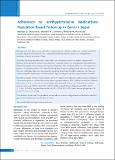Please use this identifier to cite or link to this item:
https://hdl.handle.net/20.500.14356/1769Full metadata record
| DC Field | Value | Language |
|---|---|---|
| dc.contributor.author | Bhandari, B | - |
| dc.contributor.author | Bhattarai, M | - |
| dc.contributor.author | Bhandari, M | - |
| dc.contributor.author | Ghimire, A | - |
| dc.contributor.author | Pokharel, P K | - |
| dc.contributor.author | Morisky, D E | - |
| dc.date.accessioned | 2023-05-22T06:36:05Z | - |
| dc.date.available | 2023-05-22T06:36:05Z | - |
| dc.date.issued | 2015 | - |
| dc.identifier.citation | Bhandari B, Bhattarai M, Bhandari M, Ghimire A, Pokharel PK, Morisky DE. Adherence to Antihypertensive Medications: Population Based Follow up in Eastern Nepal. J Nepal Health Res Counc. 2015 Jan-Apr;13(29):38-42. PMID: 26411711. | en_US |
| dc.identifier.issn | Print ISSN: 1727-5482; Online ISSN: 1999-6217 | - |
| dc.identifier.uri | http://103.69.126.140:8080/handle/20.500.14356/1769 | - |
| dc.description | Original Article | en_US |
| dc.description.abstract | Abstract Background: Poor adherence toward antihypertensive drugs is a worldwide problem that results in poor health outcomes and increased health care costs. Community based study related to adherence to antihypertensive medication is limited in context of Nepal. Methods: This study was conducted to explore the extent of adherence towards prescribed antihypertensive treatment and to identify the factors of non adherence. Community based cross sectional study was conducted in Dharan Municipality of Eastern Region of Nepal from September 2009 to February 2010. Out of 975 hypertensive patients, 154 calculated samples were selected following simple random sampling method. Data was collected by interview method and adherence was measured by using four items Morisky Medicine adherence scale. Data was analyzed using SPSS by descriptive and inferential (Chi square and logistic regression analysis) Statistical method. Results: Among the 154 hypertensive patients, only 56.5% patients were adherent to antihypertensive medication. The important predictors of non adherence by logistic regression analysis at 95% Confidence Interval were illiteracy (OR 5.34, CI= 1.23 -23 , P=0.025), expensive price of medicine (OR 5.14, CI=1.1-23.9, P=0.037), missed medicine due to cost (OR 0.143,CI=0.02-0.78, P= 0.025), no family history of hypertension (OR 4.46,CI= 1.21-16.4, P=0.024), irregular follow up (OR 6.39,CI=1.22-33.3, P=0.028), more than one pills per day ( OR 5.33,CI=1.19-23.7, P= 0.028). Conclusions: Around half of the population was non adherent towards antihypertensive medications so identified gap need to be addressed to increase adherence level. Keywords: Adherence; hypertension; medication. | en_US |
| dc.language.iso | en | en_US |
| dc.publisher | Nepal Health Research Council | en_US |
| dc.relation.ispartofseries | Jan-April, 2015; | - |
| dc.subject | Adherence | en_US |
| dc.subject | Hypertension | en_US |
| dc.subject | Medication | en_US |
| dc.title | Adherence to Antihypertensive Medications: Population Based Follow up in Eastern Nepal | en_US |
| dc.type | Journal Article | en_US |
| local.journal.category | Original Article | - |
| Appears in Collections: | Vol. 13 No. 1 Issue 29 January - April 2015 | |
Files in This Item:
| File | Description | Size | Format | |
|---|---|---|---|---|
| 38_42.pdf | Fulltext Download | 191.69 kB | Adobe PDF |  View/Open |
Items in DSpace are protected by copyright, with all rights reserved, unless otherwise indicated.
